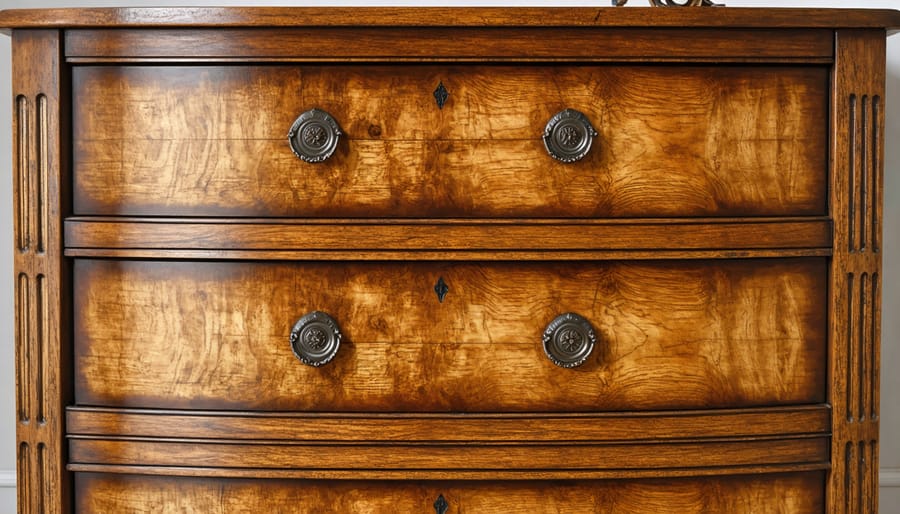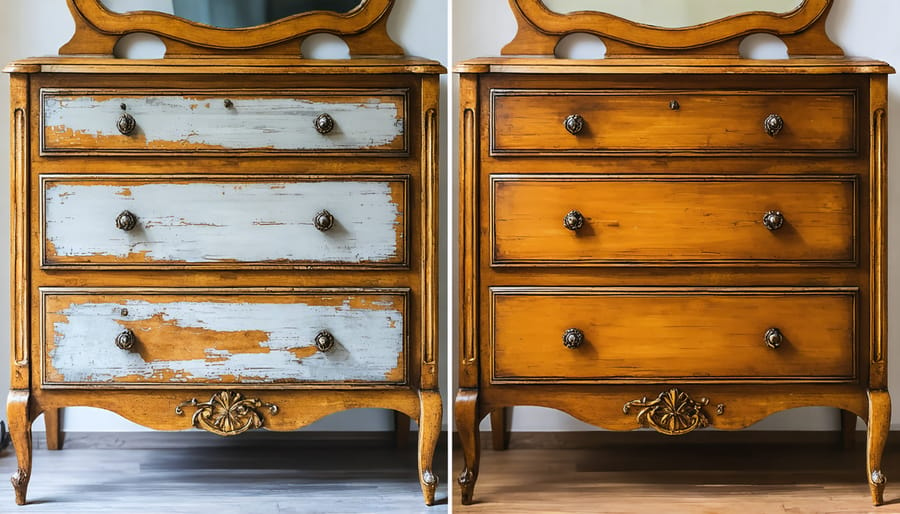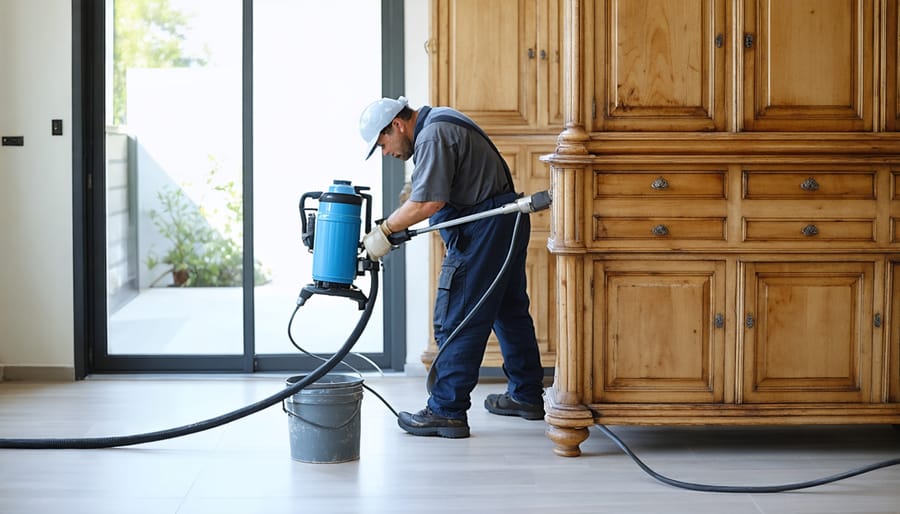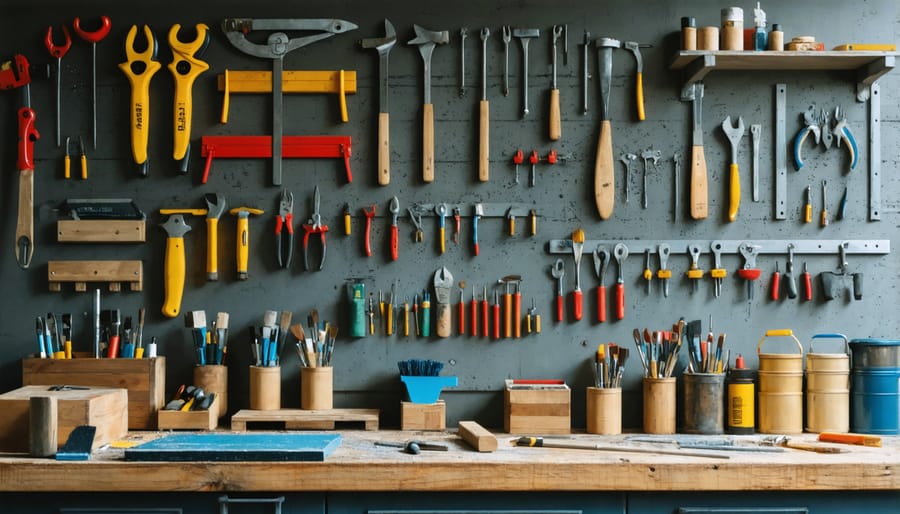
Transform aging furniture into stunning showpieces through expert finish restoration techniques that preserve both value and character. Master the art of surface preparation by methodically removing old finishes, repairing imperfections, and creating the perfect foundation for new treatments. Employ professional craftsmanship techniques to match historical finishes, from French polishing to traditional hand-rubbed oils, ensuring authenticity in every restoration project. Combine modern materials with time-tested methods to achieve superior durability while maintaining the piece’s original aesthetic appeal. Whether working with cherished antiques or contemporary pieces, proper finish restoration demands precision, patience, and an understanding of wood characteristics to deliver results that will endure for generations.
Understanding different furniture finishes is crucial for successful restoration work. Traditional lacquer provides a durable, high-gloss finish that’s resistant to most household chemicals and heat. It dries quickly and can be buffed to achieve various sheens, making it popular for both antique and contemporary pieces.
Varnish, particularly polyurethane varnish, offers excellent protection against moisture and wear. While it takes longer to dry than lacquer, it creates a harder, more durable surface that’s ideal for frequently used furniture pieces. Today’s modern finishing materials include water-based versions that are more environmentally friendly.
Shellac, derived from natural sources, remains a favorite among restoration professionals for its warm, amber glow and excellent adhesion properties. It’s particularly suitable for antique furniture and can be easily repaired or renewed. However, it’s sensitive to heat and alcohol.
Other common finishes include Danish oil, which penetrates deep into the wood while providing a natural look, and wax finishes, which offer a subtle sheen and tactile smoothness but require regular maintenance to maintain their protective properties.
Recognizing the early signs of finish deterioration can help prevent extensive damage and costly repairs. Watch for white rings or cloudy spots on the surface, which often indicate moisture damage or heat exposure. Crazing – a network of fine cracks in the finish – suggests age-related breakdown or environmental stress. Fading or discoloration, particularly in areas exposed to sunlight, signals UV damage and protective coating failure.
Pay attention to changes in texture – if the surface feels rough, sticky, or has lost its original sheen, the finish is likely breaking down. Dark spots or patches beneath the finish could indicate water infiltration or mold growth. Areas where the finish appears thin or worn, especially on edges and frequently touched surfaces, need immediate attention to prevent wood exposure.
Another telltale sign is flaking or peeling finish, which occurs when the coating loses adhesion to the wood surface. If you notice any of these symptoms, addressing them promptly can prevent further deterioration and protect your furniture’s value and appearance.

Proper surface preparation is the foundation of successful furniture finish restoration. Begin by thoroughly cleaning the piece with a mild furniture cleaner and soft cloth to remove accumulated dirt, grime, and wax buildup. For stubborn residues, a mixture of warm water and mild dish soap can be effective, but ensure you don’t oversaturate the wood.
Once cleaned, assess the surface for damage. Use fine-grit sandpaper (220-320 grit) to gently smooth any rough spots, always working in the direction of the wood grain. For deeper scratches or gouges, start with medium-grit sandpaper (150-180 grit) before progressing to finer grits. Remove all sanding dust with a tack cloth or vacuum with a brush attachment.
If the existing finish is damaged or peeling, you may need to strip it completely. Apply a quality furniture stripper according to manufacturer instructions, working in small sections. After stripping, neutralize the surface with mineral spirits and allow it to dry completely.
Before applying new finish, conduct a final inspection under good lighting. Check for any remaining imperfections, loose veneer, or areas requiring wood filler. The surface should feel smooth to the touch and appear uniform in texture. Remember, the time invested in proper preparation directly affects the quality and longevity of your restored finish.
Color matching is one of the most challenging yet crucial aspects of furniture finish restoration. Success lies in understanding both the science of color theory and the art of blending techniques. When approaching a color matching project, start by analyzing the existing finish under different lighting conditions, as colors can appear dramatically different under natural daylight versus artificial lighting.
The first step is to create a test board using the same type of wood as the piece being restored. This allows you to experiment with different stain combinations without risking damage to the original piece. Professional restorers often use a combination of pigment stains, dye stains, and toners to achieve the perfect match.
For achieving precise color matches, consider these proven techniques:
1. Layer different colored stains to build depth and complexity
2. Use glazes to adjust undertones and create aged effects
3. Apply toners to shift the overall color temperature
4. Incorporate touch-up markers for small areas
5. Utilize spray-on toners for seamless transitions
When blending new finishes into existing ones, the key is to feather the edges of your work area. This creates a gradual transition that becomes virtually invisible to the naked eye. Start with lighter applications and build up gradually – it’s always easier to add more color than to remove excess.
One often-overlooked aspect of color matching is accounting for aging and patina. Natural wood finishes typically darken and warm over time, so slightly adjusting your match to anticipate these changes can result in a more lasting restoration.
Remember to document your process, including exact measurements and mixture ratios. This information becomes invaluable for future touch-ups or when working on matching pieces of furniture. For best results, always test your color match in an inconspicuous area first and view it under various lighting conditions before proceeding with the full restoration.
Keep in mind that perfect matches often require patience and multiple attempts. Professional restorers frequently spend considerable time fine-tuning their color formulations to achieve seamless results that stand the test of time.
The success of furniture finish restoration largely depends on applying the right techniques for each specific finish type. Professional application methods vary significantly between different finishes, and understanding these distinctions is crucial for achieving optimal results.
For traditional lacquer finishes, the French polishing technique remains the gold standard. This method involves applying multiple thin layers of shellac using a special rubbing pad called a “fad” or “rubber.” Each layer is carefully buffed to create a deep, rich shine that enhances the wood’s natural beauty.
When working with polyurethane finishes, the spray application technique offers the most consistent results. Using HVLP (High-Volume, Low-Pressure) spray systems ensures even coverage while minimizing overspray and waste. The key is maintaining the proper distance and overlap pattern while spraying.
For oil-based finishes, the hand-rubbed application method produces superior results. This involves applying the finish with a lint-free cloth, working in the direction of the wood grain. Multiple thin coats are applied, with light sanding between layers, to build up a durable and attractive finish.
Varnish applications require careful attention to environmental conditions. The ideal application temperature ranges between 70-75°F with moderate humidity. Using high-quality natural bristle brushes and maintaining a “wet edge” while working prevents lap marks and ensures smooth coverage.
Water-based finishes demand quick, confident application due to their rapid drying time. Using foam applicators or synthetic brushes helps prevent bubbling and ensures smooth results. Multiple thin coats typically produce better results than fewer thick ones.
For all finish types, proper surface preparation and environmental control remain essential for success. Careful attention to dust control, temperature, and humidity levels will significantly impact the final result’s quality and durability.


Professional furniture finish restoration requires a specialized toolkit that goes beyond basic DIY equipment. A professional-grade random orbital sander with variable speed control allows for precise material removal without damaging the underlying wood. Heat guns and infrared paint removers provide controlled heat for softening old finishes, while specialized scrapers with replaceable blades ensure clean removal without gouging.
Cabinet scrapers and card scrapers are essential for achieving glass-smooth surfaces, particularly on antique pieces where maintaining original character is crucial. For detailed work, a set of quality steel wool grades (from #0000 to #2) and micro-mesh sanding pads enable progressive surface refinement.
Spray equipment, including HVLP (High Volume Low Pressure) systems, delivers professional-quality finish application. These systems require proper ventilation and spray booths for safe operation. Moisture meters help determine wood readiness for finishing, while color-matching tools and lighting systems ensure accurate restoration of original finishes.
Safety equipment is equally important, including respiratory protection with organic vapor cartridges, chemical-resistant gloves, and protective eyewear. Professional-grade dust collection systems protect both the workspace and respiratory health during sanding operations.
For precise color matching and finish analysis, professionals rely on digital color meters and finish testing kits. These tools help identify original finishes and ensure historically accurate restorations when working on valuable antiques.
Professional furniture restoration demands the highest quality materials to achieve exceptional results. Today’s market offers an impressive array of sustainable finishing products and specialized solutions that combine traditional craftsmanship with modern innovation.
For surface preparation, premium-grade sandpapers ranging from coarse to ultra-fine grits ensure proper smoothing without damaging the underlying wood. Professional-strength cleaning solutions and specialized strippers effectively remove old finishes while protecting the wood’s natural beauty.
Top-tier wood fillers and grain fillers, available in various colors and compositions, provide seamless repairs that match the original wood texture. High-quality stains, including both oil-based and water-based options, offer superior color penetration and consistency. Professional-grade sealers create a protective barrier while enhancing the wood’s natural characteristics.
For the final finish, premium lacquers, polyurethanes, and shellacs deliver lasting protection and the desired sheen level. These materials are specifically formulated for professional use, offering better flow, leveling properties, and durability compared to consumer-grade products.
Professional restorers also rely on specialized additives like retarders, accelerators, and grain enhancers to achieve specific effects and ensure optimal results in varying environmental conditions. Investing in these quality materials not only guarantees superior results but also ensures long-lasting restoration that stands the test of time.
After investing time and effort in restoring your furniture’s finish, proper maintenance is crucial for long-lasting results. Start by dusting regularly with a soft, lint-free cloth to prevent particle buildup that can scratch the surface. Avoid using harsh chemical cleaners; instead, opt for specialized furniture polish or a mixture of mild soap and water for occasional deep cleaning.
Place restored pieces away from direct sunlight and heat sources, as UV rays and temperature fluctuations can cause fading and damage. Maintain consistent indoor humidity levels between 40-50% to prevent wood expansion and contraction that could compromise the finish. Use coasters, placemats, and protective pads under items to prevent scratches and water rings.
Inspect your furniture quarterly for signs of wear or damage. Address any issues promptly to prevent them from worsening. When moving furniture, always lift rather than drag to protect the finish and legs. Consider applying a fresh coat of protective wax annually to maintain the shine and provide an additional barrier against damage.
For valuable or antique pieces, schedule professional maintenance checks every few years. Keep a detailed record of restoration work and maintenance procedures performed, which can be valuable for insurance purposes or future restoration needs. By following these preventive measures, your restored furniture finish can maintain its beauty and integrity for many years to come.
Professional furniture finish restoration is an investment that pays dividends in both the aesthetic and financial value of your pieces. By entrusting your cherished furniture to skilled craftsmen, you ensure that proper techniques, materials, and equipment are used to achieve lasting results. The restoration process not only revives the original beauty of your furniture but also adds years to its lifespan, protecting it from further deterioration.
Beyond the immediate visual improvements, professional restoration offers long-term benefits including enhanced durability, increased resale value, and preservation of historical significance for antique pieces. Regular maintenance and proper care of restored finishes will extend these benefits, making the initial investment even more worthwhile.
When weighing the decision between DIY repairs and professional restoration, consider that expert craftsmanship often proves more cost-effective in the long run. Professionals can address underlying issues that might not be apparent to the untrained eye, preventing future damage and the need for more extensive repairs. Their expertise ensures that your furniture maintains its beauty and functionality for generations to come, making professional finish restoration an essential service for anyone serious about preserving their valuable furniture pieces.